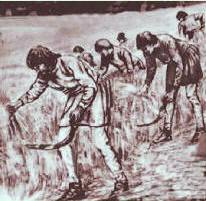|
The Middle Ages -
The Feudal System |
|


|
 |
After
the Battle of Hastings, William still had to
conquer England. He marched from Hastings,
crossing the Thames River then on towards
London. He
received the surrender of the city and took
hostages to ensure that the surrender was
kept.
William wanted to be crowned King
as soon as possible. His Coronation took place on
Christmas Day, 1066. It was held at Westminster.(http://www.bayeuxtapestry.org.uk/BayeuxAfter.htm)
|
But how was King William to
control the Saxons and organise the land?
To do this, William introduced a
system of control and authority across the land, that we know of as
Feudalism. The country was too large for the King to look after and
run by himself. So the king divided the land up and gave parts to the
Church and parts to people below him. This system and the structure of
feudalism had been well established in Europe for some time and the
Normans imposed feudalism in England.
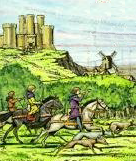 |
|
William kept the promises he had
made to the barons who fought with
him to give them English land. He
gave them lands taken from the
Saxons. In exchange, the barons had
to pay homage or be loyal to William, and provide
knights to fight for him when he
needed them. They might also have to
pay sums of money to the king.
William made sure that the barons
could not easily rise against him by
giving them pieces of land in
different parts of the country,
which made it difficult to raise a
private army in secret. |
|
|
Source A
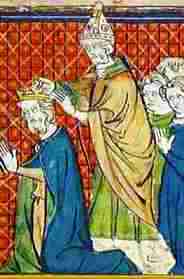 |
In their turn the barons granted
land to their followers. The knights promised in
return to pay homage, be loyal to the barons, to fight for them
when needed and to raise money when the barons
demanded it.
So
Feudalism in practice meant that the country was not
governed by the king but by individual lords, or
barons, who: ran or administered their own estates,
looked after justice - law and order, minted their
own money, levied taxes and tolls, and demanded
military service and farm work from their vassals -
the villeins (peasants), and serfs.
(http://www.britainexpress.com/History/Feudalism_and_Medieval_life.htm)
|
|
1. |
Put the following heading on the top of a new page: The Middle Ages - The Feudal System.
Under this heading, explain in a few lines what the
Feudal system was, and how it worked. |
|
2.
|
Why did William the Conqueror introduce feudalism
into England? What did his follower have to give
William, in return for being given land? |
|
3.a) |
Study Source A, a painting of a King's
coronation, where the Pope or Cardinal is making him
King. He does this by placing the golden crown on his
head.
Click the painting, and read the information on the page
that opens up, about the role and influence of the
Catholic Church during the Middle Ages.
Explain in your own words, the possible reasons
why William gave half of the land he conquered
in England, to the Church.
Questions 3.b), c)
and d) are Optional |
|
|
|
|
|
|
The social structure of authority
across a country during the Middle Ages, was organized around a system called
Feudalism.
Source B
|
|
|
4. |
Print
off this
diagram of the Feudal system and fill in the
labels from the information above. Then paste
the diagram in your book. |
|
5.
|
Compare and contrast the life of medieval
Villeins and Serfs on a Lord's Manor during the
Middle ages. In other words, explain what was
similar in their lives and what was different. |
|
6.a)
b) |
Briefly explain the three field system of
farming followed, and include the meaning of
'fallow'.
Print
of this blank map of
a Medieval Manor.
Label and colour the map and
then paste it in your book. |
|
Life on the Manor.
Most of the village people were called
villeins. The lord of the manor gave each
villein space for a house and small garden,
strips in the arable fields and a share in
the hay meadow, common land and woodland.
Instead of paying rent, the villeins would
work on certain days for the lord.In February or
March, they would do several days’ ploughing
and harrowing on the lord’s land but they
had to provide their own food. Once in
summer and once in autumn, they would be
expected to do one day’s ploughing and one
day’s harrowing, but on these occasions the
lord would give them food twice a day.
|
Source C
 |
|
There would also be other regular
work to be done on the lord’s strips, like hoeing
off the weeds. Besides this work, week by week,
there were special times when the villein’s whole
family had to work; cutting and carrying the lord’s
hay and reaping and carrying his corn.
http://www.karenleefield.com/blog/the-medieval-village.html
|

|
The Peasant's Life.
Villages
consisted of from 10-60 families living in rough huts on dirt floors,
with no chimneys or windows. Often, one end of the hut was given over to
storing livestock. They built a framework of timber, filled in the
spaces with a lattice-work of this wood, and plastered this all over
with a mixture of mud and chopped straw. In this way they made “wattle
and daub” walls. Finally, he thatched the roof with straw.
(http://www.karenleefield.com/blog/the-medieval-village.html)
Inside, there would be a flat stone for a fire in the middle of the room
and a smoke-hole in the roof above it. Furnishings were sparse; three
legged stools, a trestle table, beds on the floor softened with straw or
leaves. The peasant diet was mainly porridge, cheese, black bread, and a
few home-grown vegetables.
Peasants had a hard
life, but they did not work on Sundays or on the frequent saints' days,
and they could go to nearby fairs and markets. The lot of serfs was much
harsher. |
|
|
|
The Serf's Life.
Although
not technically a slave, a serf was bound to a lord for life. He could
own no property and needed the lord's permission to marry. Under no
circumstance could a serf leave the land without the lord's permission
unless he chose to run away. If he ran to a town and managed to stay
there for a year and a day, he was a free man. However, the serf did
have rights. He could not be displaced if the manor changed hands. He
could not be required to fight, and he was entitled to the protection of
the lord.
http://www.britainexpress.com/History/Feudalism_and_Medieval_life.htm |
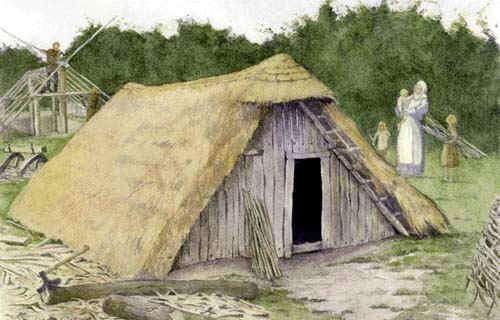
|

Source E
|
The Medieval
Village.
Villages were only
built near a stream
or spring because
they needed to be
close to water.
Houses were dotted
along a little dirt
road. Some of these
houses were nothing
more than little
huts; others were a
bit bigger. A large
manor house, with
barns and stables
surrounding it, was
where the lord and
his wife lived. You
would always find a
church nearby.
Around the village
would be three large
arable fields. One
would be for growing
wheat, one for
barley and the third
would be lying
fallow (empty) - to
allow the soil to
recover its
goodness, otherwise
the soil's nutrients
would be used up and
produce a bad crop. Each
field was divided
into strips. Most of
the village families
would have strips
scattered about in
each field, and the
lord would have his
own strips. His part
of the land is
called the demesne. |
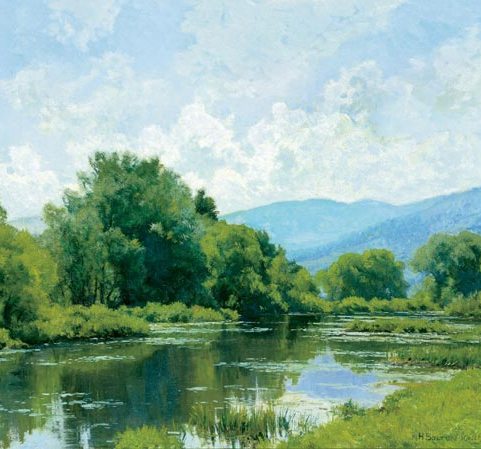
The Mill Pond |
|
The Lords Mill.
There would also be common grassland because the
people had the right to graze cattle and sheep. Near the stream,
where the ground is damp, the grass would grow tall and thick in
the hay meadow, and close by would be the watermill with its big
wheel turning round in the water as it grinds corn. This would
belong to the lord, who would also have a windmill on a hill.
Further away, beyond the fields, are dark woods,
where pigs might be kept and deer could be hunted. |
|
|
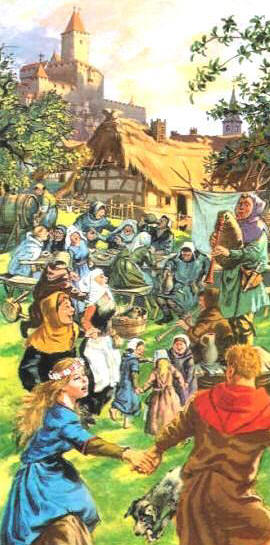
Listen to the music (Use your ear phones! Right mouse click, select 'open in a new window', minimise the
new window so
you can study the painting.) |
|
Entertainment in the Middle Ages - Holidays and
Festivals
The monotony of Medieval daily life during
the Middle ages was alleviated by the various types of
entertainment, festivals and holidays. The Medieval people of
the Middle Ages shared a common life in the work of the fields,
in the sports of the village green, and in the services of the
parish church. They enjoyed many holidays; it has been estimated
that, besides Sundays, about eight weeks in every year were free
from work. Festivities at Christmas, Easter, and May Day, at the
end of ploughing and the completion of harvest, relieved the
monotony of the daily round of labor.
Who were the people who provided the
entertainment during the Middle Ages? The Medieval entertainers
of the Middle Ages included Jesters (A fool or buffoon at
medieval courts), Mummers (Masked or costumed merrymaker or
dancers at festivals), Minstrels and Troubadours, acrobats and
jugglers and conjurers.
(http://www.middle-ages.org.uk/entertainment-middle-ages.htm)
8. Read
the above about entertainment during the Middle Ages, and also
this page:
http://www.camelotintl.com/village/entertain.html.
Write
one page of historic fiction. Describe a character's experiences
during one day at a festival or fair, during the middle ages.
Although the events you describe will be fictitious, include
accurate details about the activities, sight and sounds that you
would have seen at a medieval fair or festival. |
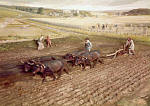

|
9.
Explore the castle:
https://www.kidsonthenet.org.uk/castle/view.html
10.
Interactive Medieval Hats Activity:
( From
Annenberg Learner )
http://www.learner.org/interactives/middleages/clothact.html
 |
| |
|
|
(http://www.interactive-learning.com.au/ )
|
| |






